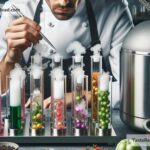The Science of Cooking with Physical Changes: Techniques and Tips
Cooking is both an art and a science. When you’re in the kitchen, you’re not just combining ingredients—you’re causing chemical and physical changes that transform raw food into delicious meals. While the chemical changes in cooking involve altering the molecular structure of food, physical changes are all about changes in texture, shape, or state of food without changing its fundamental composition.
Today, let’s explore the science of cooking with physical changes and how these techniques bring flavor and joy to our meals. Along the way, we’ll share practical tips to help you cook smarter and better!
What Are Physical Changes in Cooking?
Unlike chemical changes, where new substances are created, physical changes don’t alter the makeup of food. Instead, physical changes affect things like the shape, size, texture, or state (solid, liquid, gas). These changes are reversible most of the time.
Some common examples of physical changes in cooking include:
- Freezing: Turning water into ice or chilling fruits for smoothies.
- Cutting: Chopping vegetables or slicing bread doesn’t change their composition—it just changes their size.
- Boiling: Heating water turns it into steam, but it’s still water.
- Mixing: Combining flour and sugar creates a mixture, but the individual ingredients are unchanged.
- Melting: Turning butter into liquid form doesn’t change its chemical makeup; it just shifts its state.
Common Cooking Techniques and Physical Changes
Cooking often relies on physical changes to improve the texture, flavor, and appearance of food. Let’s take a closer look at some common physical processes in the kitchen and practical tips to master them.
1. Cutting or Chopping
What’s Happening?
When you chop food, you’re physically breaking it down into smaller pieces. This helps it cook evenly and absorb marinades or seasonings better.
Tip: Use sharp knives for smooth cuts! A dull blade crushes food instead of slicing it neatly, leading to poor texture and uneven sizes. For herbs, try a rocking motion with the knife or use kitchen scissors for easier chopping.
2. Freezing
What’s Happening?
Freezing slows the movement of molecules in food, preserving its freshness and texture. Frozen fruits like berries or bananas also gain a firmer texture, making them perfect for desserts or smoothies.
Tip: Freeze fruits or vegetables on a flat tray first, then transfer them to airtight containers. This prevents sticking and makes it easier to grab just what you need. Label your containers with the date so you know what needs to be used first.
3. Mixing and Whisking
What’s Happening?
When you mix ingredients like flour and water, you’re physically combining them. Whisking is even more dynamic: it introduces air into mixtures, creating fluffier textures (great for whipping cream or meringue).
Tip: For smoother batters, mix dry and wet ingredients separately before combining. To whisk effectively, use brisk circular motions and tilt the bowl slightly for better air circulation.
4. Melting
What’s Happening?
Turning solid butter or chocolate into a liquid state is a physical change that makes them easier to combine with other ingredients.
Tip: Melt butter or chocolate in a microwave or double boiler to prevent overheating. Stir often to maintain a smooth texture.
5. Boiling and Steaming
What’s Happening?
Boiling water generates steam, which softens and cooks food. This is especially useful for vegetables, pasta, and rice.
Tip: When boiling pasta, add salt to the water—it enhances flavor and prevents stickiness. For steaming, use a steamer basket with a tight-fitting lid to trap heat.
6. Kneading Dough
What’s Happening?
Kneading is a physical process that stretches and folds dough, giving it elasticity and structure.
Tip: To test if your dough is ready, gently poke it with a finger. If it springs back slightly, the gluten is fully developed. Avoid over-kneading, as it can make baked goods tough.
7. Shaping and Rolling
What’s Happening?
Shaping food into patties, rolls, or balls is another example of a physical change. It gives food a specific form for easier cooking and better presentation.
Tip: Dust your rolling pin and work surface with flour to prevent sticking when working with dough. For patties, press lightly to prevent cracking at the edges.
Why Understanding Physical Changes Matters
Cooking isn’t just about following recipes—it’s about understanding why techniques work. Knowing the science behind physical changes gives you greater control in the kitchen and helps you troubleshoot common problems. For instance:
- If your pasta is sticking after boiling, you know to add more water or stir frequently to keep the noodles separate.
- If your whipped cream is falling flat, you learn to whisk faster or keep the bowl chilled to trap air effectively.
By mastering these small, scientific details, you’ll cook with confidence and produce consistent, tasty results.
Final Thoughts
Cooking is a journey filled with exciting transformations. Physical changes, like cutting, freezing, boiling, or kneading, play a major role in the way we prepare, cook, and enjoy food. With a little knowledge about these processes, you can refine your skills and experiment in the kitchen.
The next time you chop vegetables, melt butter, or roll dough, take a moment to appreciate the science happening right in front of you. Whether you’re whipping cream or boiling pasta, every physical change contributes to the final masterpiece on your plate.
Happy cooking!


